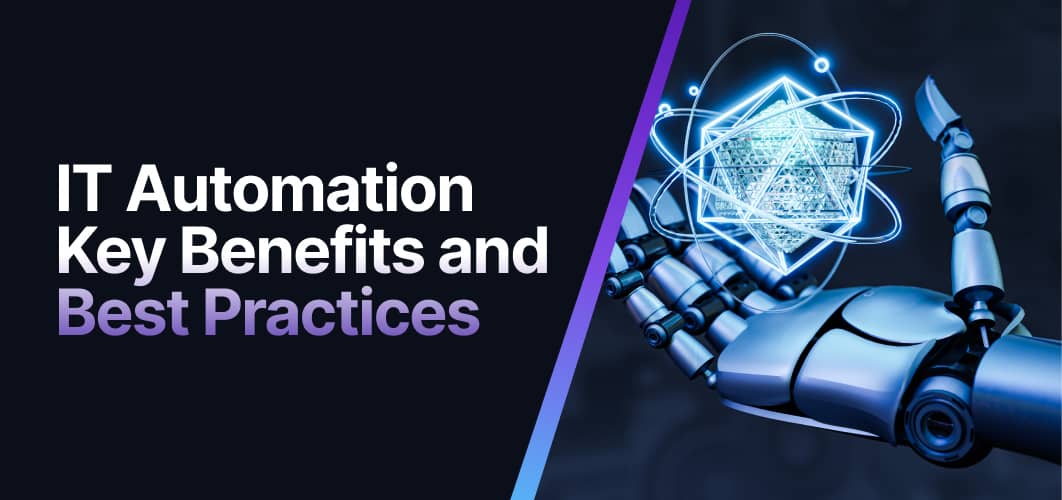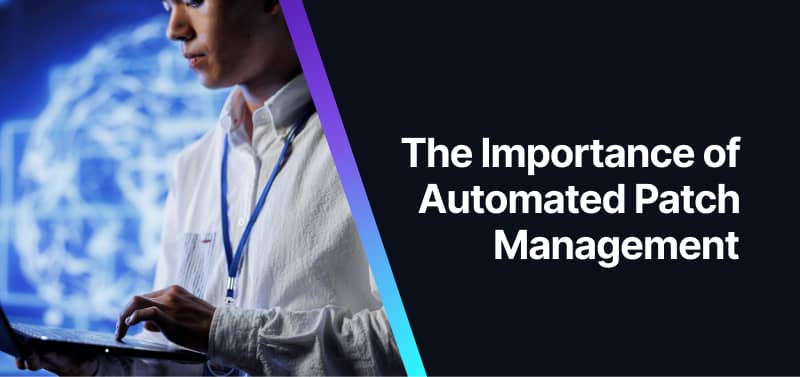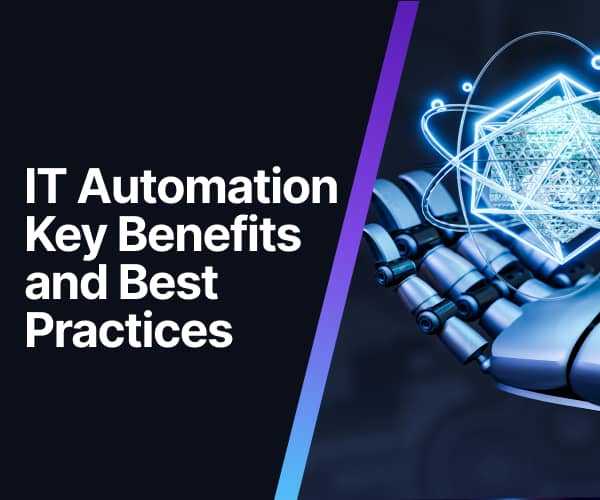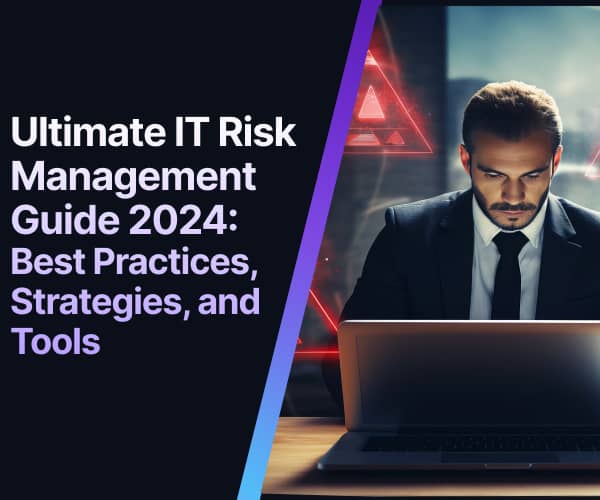IT Automation Key Benefits and Best Practices

Successful businesses handle complex IT tasks without drowning in manual work. They do it through IT automation.
IT automation means using automated systems to manage tasks such as deployment, configuration, and security monitoring in IT operations. IT automation is a top business priority because it boosts efficiency, saves time, and cuts costs. Beyond these benefits, IT automation comes with specific best practices.
At Easy2Patch, writing a detailed post about IT automation is crucial because it's revolutionizing how businesses operate today. By the end of this blog, you'll understand the challenges of manual IT tasks, and benefits of IT automations, along with some smart ways to handle them.
Let's first look at the challenges that manual IT processes bring to the table.
The Challenges of Manual IT Processes

Manual IT processes present significant challenges due to their inherent limitations. These tasks often rely on specific individuals, making processes vulnerable to errors or delays if those individuals are unavailable. Understanding these challenges is crucial for improving IT processes, security, and productivity. Let's break them down in detail:
Human Error
Manual IT processes are highly prone to human errors. These mistakes, such as data entry inaccuracies, can result in serious consequences, including financial losses, customer dissatisfaction, and compliance issues. Human error poses significant risks, especially in critical areas like patch management, where a missed or incorrect update can leave systems vulnerable.
Inefficiency and Delays
Handling tasks manually is often inefficient and slow. This can lead to delays in essential processes and projects. For example, manually managing patches can delay their application. This delay leaves systems exposed to vulnerabilities for longer periods. Such delays hinder productivity and affect a team's ability to meet deadlines and customer expectations.
Lack of Visibility and Tracking
Manual workflows lack transparency, making it difficult to monitor and track progress. This is particularly problematic in patch management, where knowing the status of each patch is essential for maintaining security. Without effective tracking, identifying and resolving bottlenecks becomes challenging.
Limited Scalability
As organizations grow, manual IT tasks become harder to manage. Scaling these processes is neither feasible nor cost-effective, limiting the company’s ability to handle increasing volumes of work. This limitation is evident in patch management, where many systems require timely updates.
Dependency on Individuals
Manual tasks often depend on specific individuals, creating risks if those people are unavailable. In patch management, this dependency can lead to critical delays if the knowledgeable staff is absent, disrupting the entire workflow.
Inefficient Collaboration
Manual processes hinder collaboration and communication between departments. This inefficiency can cause miscommunication and delays in information sharing, which are critical in coordinated tasks like patch management.
Compliance and Audit Risks
Manual handling of data often lacks standardized processes and proper documentation. This can lead to compliance violations and complicated audits. In patch management, failing to document applied patches accurately can result in non-compliance with industry regulations.
Difficulty in Data Analysis and Reporting
Extracting and analyzing data manually is time-consuming and error-prone. Generating accurate reports becomes difficult, impacting the ability to make informed decisions. In patch management, this can lead to missed vulnerabilities and inadequate security measures.
Unpatched Systems: Relying on humans to patch systems introduces significant dangers which can result in profound consequences. Unpatched systems are a major IT issue, which we will detail further in the next section.
What are the risks associated with unpatched systems?
Security Vulnerabilities
Unpatched systems are prime targets for cyberattacks, including malware and ransomware. These vulnerabilities can be exploited by attackers, leading to unauthorized access and significant security breaches.
Potential Data Breaches
Exploitable vulnerabilities in unpatched systems can result in data leaks and breaches, compromising sensitive information and putting both clients and companies at risk. Research from Darkreading reported that 60% of data breaches are linked to unpatched vulnerabilities.
Compliance Issues and Regulatory Fines
Organizations that fail to patch systems may violate industry regulations, leading to hefty fines and penalties. Maintaining up-to-date patches is often a regulatory requirement to ensure security and data protection.
Decreased Productivity and Downtime
Unpatched systems are more likely to suffer from disruptions and downtime due to security incidents. This can severely impact business operations, productivity, and revenue.
Malware Attacks
Malicious software, like ransomware, often exploits known vulnerabilities in unpatched systems, causing data breaches, system disruptions, and financial losses.
Zero-Day Exploits
These vulnerabilities are exploited by attackers before software vendors release patches. Unpatched systems are particularly susceptible to zero-day exploits, which can cause significant damage before mitigation is possible.
Credential Theft
Attackers can steal credentials from unpatched systems, leading to unauthorized access and potential data breaches. This risk is heightened by the increasing sophistication of cyberattacks.
Lateral Movement
Once inside a network, attackers can move laterally from one unpatched system to another, escalating their control and causing widespread damage.
Resource Exhaustion Attacks
Exploited vulnerabilities can lead to resource exhaustion, causing system slowdowns or crashes. This can disrupt operations and reduce the overall efficiency of IT systems.
Loss of Trust
Clients and partners may lose trust in an organization if they become aware of unpatched systems. Maintaining a strong security posture is essential for preserving reputation and customer confidence.
High Risk of Data Loss
Unpatched systems are at a higher risk of data loss due to potential exploits. Attackers can access, alter, or destroy data, leading to significant losses and operational disruptions.
The Benefits of IT Automation
Customers, employees, investors, and partners are involved in a business and each one has a unique need. Automation helps organizations free up their workforce for important tasks and strategic projects. Choosing where to automate allows companies to focus their time and resources on growing their business. Automation is a game-changer that improves efficiency and takes your IT performance to the next level. If you're thinking about diving into automation, here are the key benefits:

1- Increased Efficiency and Productivity
- Automation of Repetitive Tasks: Automates routine processes such as data entry, backups, and software updates, reducing the need for manual intervention and increasing overall efficiency.
- Freeing Up IT Staff: By automating everyday tasks, IT staff can focus on strategic initiatives, such as system improvements and innovation, leading to better resource allocation.
- Faster Task Completion: Automated systems can complete tasks more quickly than humans, ensuring faster turnaround times for routine operations.
- Scalability: Automation enables businesses to scale operations without needing a proportional increase in staff, allowing for growth without added labor costs.
- Continuous Operation: Automated systems can run 24/7 without breaks, ensuring uninterrupted productivity and maximizing uptime.
- Focus on Value-Adding Tasks: With automation handling repetitive work, employees can dedicate their time to important, value-adding tasks that drive business growth.
2- Enhanced Accuracy and Consistency
- Reduction of Human Error: Automation reduces the likelihood of mistakes that can occur with manual data entry and processing, ensuring more accurate outcomes.
- Precision in Critical Processes: Tasks requiring high precision, such as data analysis and compliance reporting, benefit from automation, which ensures these tasks are performed correctly every time.
- Adherence to Predefined Rules: Automated systems follow set rules and workflows, which eliminates variations and guarantees consistent results.
- Reliable Outcomes: Consistency in task execution helps maintain high-quality standards, providing more dependable results for critical business processes.
- Quality Maintenance: Automated systems help maintain the desired quality standards by consistently executing tasks without deviation.
- Mistake Reduction: By removing the element of human error, automation leads to more reliable outcomes, crucial for maintaining business integrity.
3- Cost Savings
- Labor Cost Reduction: Automation minimizes the need for manual labor, leading to significant savings on labor costs over time.
- Error Cost Minimization: Decreasing the likelihood of costly mistakes reduces potential financial losses associated with human errors.
- Resource Optimization: Automation optimizes the use of resources, ensuring they are utilized efficiently and effectively, which contributes to cost savings.
- Downtime Reduction: Automated systems can reduce downtime by quickly handling routine maintenance and updates, leading to continuous operation and cost efficiency.
- Focus on High-Skill Tasks: With automation taking care of routine tasks, IT teams can concentrate on high-skill, creative tasks that drive business growth and innovation.
- Enhanced Value: Overall, the savings on labor and error costs, combined with optimized resource use, enhance the value derived from automation.
4- Improved Compliance and Security
- Consistent Compliance: Automated systems ensure that processes consistently follow regulatory guidelines and internal policies, reducing the risk of non-compliance.
- Detailed Audit Trails: Automation provides comprehensive tracking and logging of activities, creating detailed records that are essential for audits and compliance verification.
- Automatic Patching and Updating: Automation ensures that patches and updates are applied promptly, reducing vulnerability exposure and enhancing system security.
- Vulnerability Monitoring: Automated systems continuously monitor for vulnerabilities, enabling quick identification and remediation of potential security issues.
- Real-Time Incident Response: Automation allows for immediate responses to security incidents, minimizing the potential impact and improving overall security posture.
- Regulatory Adherence: Automated systems streamline compliance tasks, making it easier to adhere to industry regulations and standards, thus avoiding legal issues.
- Anomaly Detection: Automated monitoring systems can quickly detect anomalies and potential security breaches, ensuring timely alerts and interventions.
- Data Security: Automation enhances protection against cyber threats, reducing the risk of data breaches and loss.
- Reduced Risk: Overall, automated security measures and compliance tracking reduce the risk of security breaches and associated costs, enhancing organizational security and integrity.
The Importance of Automated Patch Management
Effective patch management is crucial for IT security and system stability. It means applying updates, fixes, and improvements promptly to software and systems to fix vulnerabilities, bugs, and performance issues.

Automated patch management solutions give organizations control and a clear view of how patches are applied across their networks. This means patches get deployed quickly and consistently, which cuts down on the time hackers have to exploit vulnerabilities. It also helps with following regulations. Automated systems make testing and installing patches smoother, so systems stay up and running better. But, manual patching can bring big challenges, risking security and efficiency. In this section, we will explore these challenges and highlight the benefits of automated patch management.
The Challenges of Manual Patch Management
Rising Vulnerabilities
The rapid increase in vulnerabilities, especially with the rise of ransomware attacks and zero-day exploits, poses a significant challenge. Organizations must stay alert and constantly update their systems to mitigate these risks. Manual patch management struggles to keep pace with this rapid increase and exposes systems to risks of exploitation and data breaches.
Exploits and Weaponization
Exploits are being weaponized faster than ever before. Delayed patching under manual processes leaves systems vulnerable for longer periods, increasing the likelihood of exploitation. This not only impacts security but also risks financial losses and reputational damage.
Slow Remediation Times
Timely patch deployment is critical to minimize exposure to threats. However, manual processes often result in slower response and remediation times due to the complexity of coordinating patches across various systems and applications. Balancing speed with accuracy is essential to prevent operational disruptions.
Third-Party Challenges
Managing patches for third-party applications adds another layer of complexity. It requires extensive resources and tracking to ensure all software components are updated promptly. Errors in this process can create security gaps, leaving systems vulnerable to security gaps and potential breaches.
The Benefits of Automated Patch Management
- Centralized control and visibility over the patching process
- Timely and consistent deployment of patches across the network
- Reduced risk of security vulnerabilities and compliance violations
- Minimized system downtime and improved overall performance
Real-World Applications of IT Automation
It's time to uncover the true potential of IT automation across industries. By exploring the real-world examples below, businesses can see its benefits and make smarter decisions.
In the finance and banking sector, notable companies like JPMorgan Chase and HSBC have successfully implemented IT automation to enhance their operations:
- JPMorgan Chase has automated numerous back-office processes, including data entry, report generation, and transaction processing. This company has significantly improved efficiency and reduced operational costs through leveraging machine learning and Robotic Process Automation (RPA). These technologies help them process vast amounts of data more accurately and swiftly than manual methods. Learn more.
- HSBC has automated its fraud detection systems to enhance security measures. By using advanced algorithms to detect and respond to potential fraudulent activities in real-time, now the bank can offer better protection to its customers and reduce the risk of financial crimes.
Walmart is a major player in the retail industry:
- Walmart invested in automation to improve its operations. They use robots to manage inventory by scanning shelves for out-of-stock items, incorrect prices, and wrong or missing labels. This automation ensures better inventory accuracy and allows employees to dedicate more time to customer service. Moreover, Walmart has automated parts of its supply chain to boost efficiency and cut costs.
Siemens is a leading global company in the field of manufacturing:
- Siemens has incorporated automation and AI into its operations. They use digital twins—virtual models of their physical assets—to simulate, predict, and optimize their production processes. This approach enhanced their productivity, reduced downtime, and improved quality control. Additionally, Siemens employs AI for predictive maintenance, which identifies potential equipment failures before they happen.
Royal Philips, a leader in healthcare:
Royal Philips has implemented automation to enhance patient care and operational efficiency. They use AI algorithms for diagnostic imaging, which assists radiologists in detecting anomalies in medical images more accurately and quickly. Philips also employs automation in patient data management, ensuring that healthcare providers have timely access to critical patient information, which improves the overall quality of care.
Best Practices for Implementing IT Automation
In this section, we've outlined essential best practices for implementing IT automation. These practices are crucial for ensuring smooth and effective automation across almost all businesses:
- Select Processes Fit for Automation: First, choose tasks like patch management that are repetitive and high-volume for automation. Automation greatly benefits these tasks by increasing accuracy and operating 24/7 without human intervention. Automated patch management ensures updates are timely and vulnerability exposure is reduced.
- Think Big, Start Small: Begin automating simpler aspects to build confidence and show early benefits. This approach allows your team to learn and adjust without risking critical systems. Then, you can gradually expand the automation to more complex processes as they become more familiar and capable.
- Before Automating, Optimize: Before automating, streamline and optimize existing processes. In other words, Identify and resolve any blockages or unnecessary steps before automating. This ensures that the automated workflows are efficient and effective. It also helps minimize the risk of automating inefficient practices and maximize the return on investment in automation.
- Determine Needs and Requirements: Understand the specific requirements and goals within your organization. Consider factors such as patching frequency, system criticality, and compliance requirements. This clarity helps in selecting or developing automation solutions that best fit your organization's needs.
- Assess Methodology for Solutions: Evaluate existing automation solutions and tools available in the market. Then, determine if customization is necessary to meet your unique business requirements.
Consider factors like integration capabilities, vendor support, and long-term viability. For instance, off-the-shelf solutions (pre-made, commercially available software or tools designed for general use) may offer quicker deployment but might require customization to fully integrate with existing systems and workflows.
- Ensure Risk and Security Reviews: Conduct thorough risk assessments before implementing automation. For instance, address potential risks such as system downtime from failed patches or security vulnerabilities arising from incomplete updates. Ensure that automated processes comply with security standards and regulatory requirements.
- Develop a Test Solution: Create a test environment to pilot automated processes. Test the solution rigorously to validate its functionality, performance, and compatibility with your IT infrastructure. Obtain stakeholder confirmation and feedback before proceeding with full-scale deployment.
- Monitoring and Measuring Impact: Establish key performance indicators (KPIs) to measure the impact of automated patch management. Metrics may include patch deployment speed, reduction in vulnerability exposure time, and improvement in system stability. Regularly monitor these metrics to identify areas for further optimization.
- Use a Standardized Toolset: Adopt a standardized automation toolset that integrates with your existing IT environment. Standardization simplifies maintenance, ensures consistency across different systems, and facilitates troubleshooting.
- Automate Security and Compliance: Enhance your IT environment by automating associated security scans, monitoring, and compliance checks. Automated security scans can detect vulnerabilities promptly, while automated compliance ensures that patches are applied correctly and adhere to regulatory standards.
- Training and Upskilling: Invest in training and upskilling IT staff to manage the automation process effectively. Provide training on the use of automation tools, monitoring processes, and interpreting results. Foster a culture of continuous learning to keep pace with technological advancements in patch management and automation.
- Monitor and Evaluate Results: Continuously monitor the results through ongoing assessment of KPIs and performance metrics. Evaluate the effectiveness of automation in reducing patching time, minimizing errors, and enhancing overall IT security and compliance.
How E2P Patch Manager Can Help Streamline IT Automation
Easy2Patch Patch Manager simplifies patching, enhances security, and optimizes IT processes. It also simplifies patch management for third-party applications within Microsoft Configuration Manager (SCCM) and Intune.
Let's see why Easy2Patch is a great choice for reliable automated patch management:
Effortless Third-Party Patching
E2P Patch Manager updates third-party products on computers within IT infrastructures. It integrates smoothly with WSUS, ConfigMgr, and Intune. This means it fits well with your current IT setup.
Addressing Patch Management Challenges
Automation: E2P automates the patch management process. This reduces manual work and the risk of human errors. It ensures patches are applied consistently and reliably.
Timely Deployment: E2P makes sure patches are deployed on time. This boosts security and compliance. Automated scheduling and deployment prevent vulnerabilities and keep systems updated.
Centralized Control: With E2P, administrators get centralized visibility and control over patching. This improves efficiency and reduces complexity. Managing and monitoring patching becomes easier.
Benefits of Using Easy2Patch
Time and Resource Savings: Automation saves valuable time and resources. IT teams can focus on strategic tasks rather than routine patching.
Enhanced Security and Compliance: Timely patch deployment strengthens security. It ensures compliance with industry standards. E2P helps protect against vulnerabilities and security breaches.
System Stability and Performance: Minimized downtime leads to better system stability and performance. Patches are applied without disrupting operations. Systems remain stable and perform well.
Cost-Effective Solution: E2P offers an affordable way to streamline IT operations. It reduces costs associated with manual patching. Overall IT efficiency improves.
Conclusion
In summary, IT automation is a powerful tool that drives efficiency, accuracy, and cost savings across various industries. Automating IT repetitive tasks helps businesses free up valuable resources and allows their IT staff to focus on strategic initiatives. Enhanced accuracy, improved compliance, and strengthened security are just a few of the numerous benefits that IT automation offers.
When it comes to patch management, automation is essential. Automated patch management ensures timely deployment of updates, significantly reducing the risk of vulnerabilities and compliance issues. It also provides centralized control and visibility, enhancing overall system stability and performance.
Easy2Patch offers a reliable and efficient solution for automated patch management. Take the next step today and request a demo or start a free trial of Easy2Patch and experience the benefits of automated patch management firsthand.
Frequently Asked Questions
IT automation refers to the use of technology to perform tasks with minimal human intervention. It enhances efficiency, reduces human error, and allows IT professionals to focus on strategic issues rather than routine tasks like backups, updates, and maintenance. For example, network administrators can set up automated scripts for routine tasks like backups, updates, and system maintenance, allowing them to focus on more strategic issues. IT automation improves productivity, reliability, and consistency in operations.
Organizations face several challenges with manual IT processes, such as:
- Human Error: Manual workflows are prone to mistakes, leading to inefficiencies and inaccuracies.
- Inefficiency and Delays: Manual tasks take longer and hinder agility.
- Lack of Visibility and Tracking: Manual processes lack transparency.
- Limited Scalability: Manual workflows struggle to handle growth.
- Dependency on Individuals: Relying on specific people can be risky.
- Compliance and Audit Risks: Manual processes may not meet regulatory requirements.
- Difficulty in Data Analysis and Reporting: Manual data handling is cumbersome.
- Generative AI + Intelligent Automation: Expanding the use of generative AI to enhance intelligent automation capabilities, enabling predictive analytics, anomaly detection, and intelligent decision-making.
- Digital Worker-First Processes: Prioritizing automation tools and processes to support and augment human workers effectively.
- Evolving from Pure Play to Platform Play: Moving towards comprehensive automation solutions that integrate various technologies like AI, ML, and IoT for more holistic automation strategies.
- Strategic Applications: Focusing automation efforts on specific business needs such as smart cities, industrial automation, and connected healthcare, where IoT devices generate massive data streams that automation processes can leverage for real-time insights and actions.
- Better User Accessibility for Citizen Developers: Empowering non-technical users to utilize automation tools effectively, supported by low-code/no-code development platforms.
- Ethical Automation and ESG Compliance: Implementing responsible automation practices that consider ethical implications and Environmental, Social, and Governance (ESG) factors, ensuring compliance and sustainable automation practices.
Essential tools and technologies for IT automation include:
- Robotic Process Automation (RPA): Automates repetitive tasks like data entry and invoice processing.
- Artificial Intelligence (AI) and Machine Learning (ML): Enhance decision-making and predictive capabilities, used in applications like chatbots and predictive maintenance.
- Low-Code/No-Code Development: Simplifies application development and automation workflow creation.
- Workflow Automation Platforms: Provides centralized management and control of automation processes.
- Natural Language Processing (NLP): Enables conversational AI for improved user interaction.
- Generative AI: Expands automation capabilities through creative tasks and problem-solving.
- Event-Based Scheduling Tools: Automates tasks triggered by predefined events.
- Asset Management Solutions: Tracks and manages physical and digital assets in real-time.
IT Automation Key Benefits and Best Practices

What Is Vulnerability Management?

Ultimate IT Risk Management Guide 2024: Best Practices, Strategies, and Tools

Best Practices for IT Infrastructure Management in 2024

What is Windows Patch Management? Features, Challenges, and Best Practices in 2024

What are the Cybersecurity Risks Associated with Outdated Software and Operating Systems?





